 | | | Switch to: Europe, USA, New Zealand, Antarctica Credit: NOAA/Ovation  Planetary K-index Planetary K-index
Now: Kp= 2 quiet
24-hr max: Kp= 2 quiet
explanation | more data
Interplanetary Mag. Field
Btotal: 8.55 nT
Bz: -4.39 nT south
more data: ACE, DSCOVR
Updated: Today at 1146 UT  Coronal Holes: 13 May 22 Coronal Holes: 13 May 22 
Solar wind flowing from the indicated coronal hole should reach Earth on May 16-17. Credit: SDO/AIA  Noctilucent Clouds Noctilucent Clouds
NASA's AIM spacecraft has started monitoring the north pole for signs of noctilucent clouds. The first NLCs of the season are expected to appear in mid-May. Switch view: Europe, USA, Asia, Polar Updated May13  SPACE WEATHER
NOAA Forecasts | | Updated at: 2022 May 13 2200 UTC FLARE | 0-24 hr | 24-48 hr | CLASS M | 45 % | 45 % | CLASS X | 10 % | 10 % |  Geomagnetic Storms: Geomagnetic Storms:
Probabilities for significant disturbances in Earth's magnetic field are given for three activity levels: active, minor storm, severe storm Updated at: 2022 May 13 2200 UTC Mid-latitudes | 0-24 hr | 24-48 hr | ACTIVE | 25 % | 25 % | MINOR | 10 % | 10 % | SEVERE | 01 % | 01 % | High latitudes | 0-24 hr | 24-48 hr | ACTIVE | 15 % | 15 % | MINOR | 30 % | 30 % | SEVERE | 40 % | 40 % | | | |  | | | | | | | | | | | Never miss another geomagnetic storm. Sign up for Space Weather Alerts and you'll receive a text message when magnetic storms erupt. Aurora your guides and professional astronomers use this service. You can, too! | | | SLIGHT CHANCE OF STORMS TODAY: One of the many CMEs that appeared to miss Earth this week might hit after all. NOAA analysts say that a glancing blow is possible today, potentially turning Friday the 13th into a lucky day for high-latitude aurora watchers. This is a low confidence forecast. Minor G1-class geomagnetic storms are possible if the CME grazes Earth's magnetic field. Solar flare alerts: SMS Text THE FIRST SUNQUAKE OF SOLAR CYCLE 25: Twenty-six years ago, researchers discovered seismic activity on the sun. A team led by Dr. Alexander Kosovichev, then at Stanford University, found circular waves rippling from the core of some solar flares, like this: 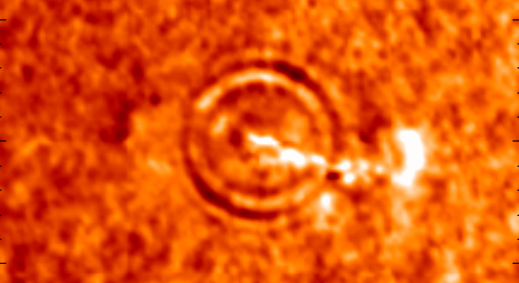
Above: The first known sunquake, recorded by SOHO on July 9, 1996. [more]
They named the tremors "sunquakes"--much like earthquakes except incredibly more powerful. A typical sunquake contains 40,000 times the energy released in the great San Francisco earthquake of 1906. These solar seismic waves appear to be compression waves like the "P" waves generated by an earthquake. They travel through the sun's interior and probably recombine on the opposite side of the sun to create a faint duplicate of the original ripple pattern.
Kosovichev and colleagues have since observed hundreds of sunquakes. Not all flares produce them, which is a mystery. Moreover, the ripples behave strangely. A typical wave starts off at an initial speed of ~20,000 mph, then accelerates to a maximum of 250,000 mph before disappearing. No one knows exactly why. "We have just detected the first sunquake of Solar Cycle 25," announces Kosovichev, who is now a professor at the New Jersey Institute of Technology (NJIT). "It rippled away from the X1.5-class solar flare of May 10, 2022." The movie below, centered on the blast site, shows concentric rings emerging from the turbulent surface of the sun: 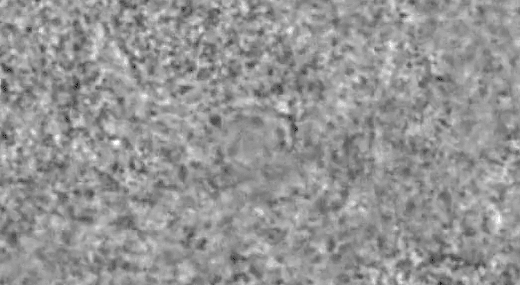
Above: A sunquake on May 10, 2022. Dopplergram movie credit: NASA/SDO
When Kosovichev discovered sunquakes in 1996, he stretched the images fourfold to highlight the ripples for press releases. This week's sunquake he has left in its raw form--not quite as easy to see, but just as impressive for a different reason. "I wanted people to appreciate how the ripples are nearly overwhelmed by turbulence," he explains. "This is why it took us so long to discover them." Solar Cycle 25 is intensifying rapidly and many more sunquakes are in the offing. The mysterious ripples could teach researchers a great deal about the magnetic underpinnings of sunspots and how they produce the strongest flares. "We are ready to learn," says Kosovichev. Let the tremors begin. Solar flare alerts: SMS Text
Realtime Space Weather Photo Gallery
Free: Spaceweather.com Newsletter A DRAGONFLY IN THE STRATOSPHERE: Are you looking for a far-out gift? Consider the Sterling Silver Dragonfly. On Jan 12th, this winged pendant flew 113,451 feet above the Sierra Nevada mountains of California, hitching a ride onboard an Earth to Sky Calculus cosmic ray balloon:
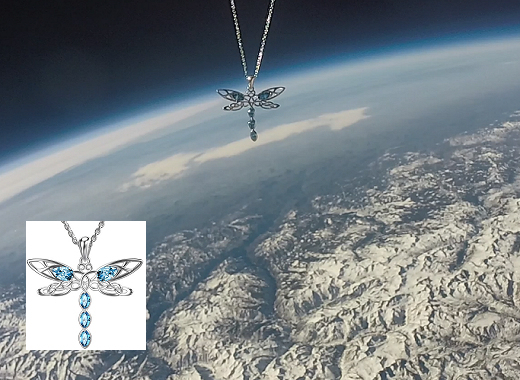
You can have it for $172.95. The dragonfly's heart is a Celtic love knot, and its wings are decorated with blue marquise crystals--all plated with 14k white gold. It's an exquisite ensemble for birthdays, anniversaries or any other romantic occasion. The students are selling dragonfly pendants to support their cosmic ray ballooning program. Each one comes with a greeting card showing the pendant in flight and telling the story of its trip to the stratosphere and back again. Far Out Gifts: Earth to Sky Store
All sales support hands-on STEM education
Realtime Aurora Photo Gallery
Free: Spaceweather.com Newsletter Every night, a network of NASA all-sky cameras scans the skies above the United States for meteoritic fireballs. Automated software maintained by NASA's Meteoroid Environment Office calculates their orbits, velocity, penetration depth in Earth's atmosphere and many other characteristics. Daily results are presented here on Spaceweather.com. On May 13, 2022, the network reported 12 fireballs.
(7 sporadics, 4 eta Aquarids, 1 eta Lyrid) 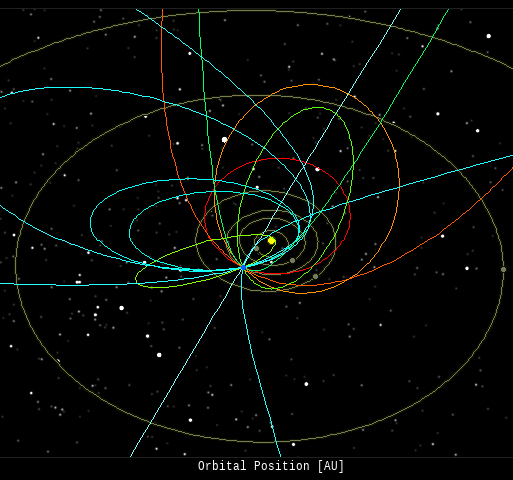 In this diagram of the inner solar system, all of the fireball orbits intersect at a single point--Earth. The orbits are color-coded by velocity, from slow (red) to fast (blue). [Larger image] [movies] Potentially Hazardous Asteroids ( PHAs) are space rocks larger than approximately 100m that can come closer to Earth than 0.05 AU. None of the known PHAs is on a collision course with our planet, although astronomers are finding new ones all the time. On May 13, 2022 there were 2279 potentially hazardous asteroids.
 | Recent & Upcoming Earth-asteroid encounters: | Asteroid | Date(UT) | Miss Distance | Velocity (km/s) | Diameter (m) | | 2022 JC | 2022-May-08 | 6.9 LD | 6.2 | 32 | | 2022 HF1 | 2022-May-08 | 8.8 LD | 17.1 | 59 | | 2022 JL2 | 2022-May-08 | 6.7 LD | 13.2 | 18 | | 2022 JF2 | 2022-May-08 | 4 LD | 7.8 | 11 | | 2022 JY1 | 2022-May-08 | 3.3 LD | 11.4 | 15 | | 2022 HL3 | 2022-May-08 | 11.7 LD | 11.7 | 52 | | 467460 | 2022-May-09 | 14.9 LD | 11.3 | 499 | | 2022 JM | 2022-May-09 | 1 LD | 4.9 | 6 | | 2022 JD1 | 2022-May-10 | 3.6 LD | 11 | 16 | | 2022 JO1 | 2022-May-10 | 0.2 LD | 13.9 | 13 | | 2019 JE | 2022-May-11 | 4.9 LD | 7.2 | 21 | | 2022 JT1 | 2022-May-11 | 18.3 LD | 21.2 | 53 | | 2022 JB1 | 2022-May-11 | 12.7 LD | 12.1 | 44 | | 2022 JQ | 2022-May-11 | 8.6 LD | 25.1 | 45 | | 2022 JV1 | 2022-May-12 | 2.1 LD | 6.5 | 11 | | 2022 JR | 2022-May-12 | 7.4 LD | 9.4 | 22 | | 2022 JP1 | 2022-May-13 | 2.6 LD | 22.6 | 41 | | 2022 JO | 2022-May-15 | 8.8 LD | 7.7 | 25 | | 2022 JU | 2022-May-15 | 19.9 LD | 6 | 26 | | 2012 UX68 | 2022-May-15 | 2.8 LD | 8.2 | 54 | | 388945 | 2022-May-15 | 15 LD | 8.2 | 293 | | 2022 JC1 | 2022-May-16 | 6.4 LD | 10 | 31 | | 2013 UX | 2022-May-17 | 16.8 LD | 16.3 | 141 | | 2021 WY | 2022-May-18 | 16.9 LD | 9 | 65 | | 2022 JQ1 | 2022-May-19 | 11.5 LD | 4.9 | 22 | | 2022 HD1 | 2022-May-20 | 15.3 LD | 6.8 | 60 | | 7335 | 2022-May-27 | 10.5 LD | 13.1 | 1078 | | 2022 JU1 | 2022-May-27 | 15.1 LD | 6.1 | 37 | | 2022 JY | 2022-May-28 | 15.1 LD | 10.9 | 67 | | 2021 KO2 | 2022-May-30 | 3.1 LD | 14.8 | 9 | | 2022 HT2 | 2022-May-30 | 11.9 LD | 15.7 | 224 | | 2020 DA4 | 2022-Jun-01 | 5.5 LD | 8.9 | 26 | | 2021 GT2 | 2022-Jun-06 | 9.5 LD | 7.5 | 50 | | 2018 LU2 | 2022-Jun-09 | 14.8 LD | 10.7 | 16 | | 2006 XW4 | 2022-Jun-12 | 5.9 LD | 7.3 | 49 | | 2022 GU6 | 2022-Jun-12 | 3.2 LD | 8.4 | 88 | | 2015 WP2 | 2022-Jun-26 | 18.5 LD | 11.4 | 3 | | 2022 JE1 | 2022-Jul-03 | 8.5 LD | 5.6 | 71 | | 2021 EL4 | 2022-Jul-05 | 19.8 LD | 9.5 | 25 | Notes: LD means "Lunar Distance." 1 LD = 384,401 km, the distance between Earth and the Moon. 1 LD also equals 0.00256 AU. MAG is the visual magnitude of the asteroid on the date of closest approach. | | Cosmic Rays in the Atmosphere | SPACE WEATHER BALLOON DATA: Almost once a week, Spaceweather.com and the students of Earth to Sky Calculus fly space weather balloons to the stratosphere over California. These balloons are equipped with sensors that detect secondary cosmic rays, a form of radiation from space that can penetrate all the way down to Earth's surface. Our monitoring program has been underway without interruption for 7 years, resulting in a unique dataset of in situ atmospheric measurements. Latest results (Nov. 2021): Our balloons have just measured a sudden drop in atmospheric radiation. It happened during the strong geomagnetic storms of Nov. 3-4, 2021. Here are the data: 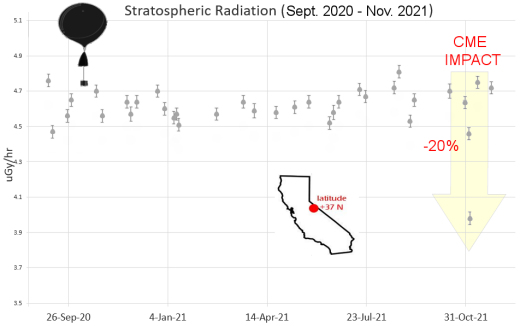
This is called a "Forbush decrease," named after American physicist Scott Forbush who studied cosmic rays in the early 20th century. It happens when a CME from the sun sweeps past Earth and literally pushes cosmic rays away from our planet. Radiation from deep space that would normally pepper Earth's upper atmosphere is briefly wiped out. We have measured Forbush decreases before. For example, here's one from Sept. 2014. The Forbush Decrease of Nov. 3-4, 2021, was the deepest in the history of our 7-year atmospheric monitoring program. Radiation levels in the stratosphere over California dropped nearly 20%, more than doubling the previous record from our dataset. En route to the stratosphere, our sensors also pass through aviation altitudes, so we can sample radiation where planes fly. This plot shows how the Forbush decrease was restricted to the stratosphere; it did not affect lower levels of the atmosphere: 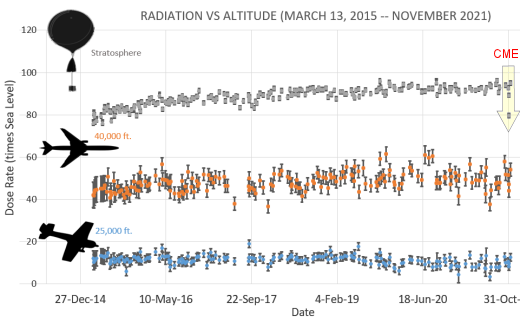
The dose rates shown above are expressed as multiples of sea level. For instance, we see that boarding a plane that flies at 25,000 feet exposes passengers to dose rates ~10x higher than sea level. At 40,000 feet, the multiplier is closer to 50x. The higher you fly, the more radiation you will absorb. .Who cares? Cosmic rays are a surprisingly "down to Earth" form of space weather. They can seed clouds, trigger lightning, and penetrate commercial airplanes. According to a study from the Harvard T.H. Chan school of public health, crews of aircraft have higher rates of cancer than the general population. The researchers listed cosmic rays, irregular sleep habits, and chemical contaminants as leading risk factors. Somewhat more controversial studies (#1, #2, #3, #4) link cosmic rays with cardiac arrhythmias and sudden cardiac death. .Technical notes: The radiation sensors onboard our helium balloons detect X-rays and gamma-rays in the energy range 10 keV to 20 MeV. These energies span the range of medical X-ray machines and airport security scanners. Data points in the first graph ("Stratospheric Radiation") correspond to the peak of the Regener-Pfotzer maximum, which lies about 67,000 feet above central California. When cosmic rays crash into Earth's atmosphere, they produce a spray of secondary particles that is most intense at the entrance to the stratosphere. Physicists Eric Regener and Georg Pfotzer discovered the maximum using balloons in the 1930s and it is what we are measuring today. | | The official U.S. government space weather bureau | | | The first place to look for information about sundogs, pillars, rainbows and related phenomena. | | | Researchers call it a "Hubble for the sun." SDO is the most advanced solar observatory ever. | | | 3D views of the sun from NASA's Solar and Terrestrial Relations Observatory | | | Realtime and archival images of the Sun from SOHO. | | | information about sunspots based on the latest NOAA/USAF Active Region Summary | | | from the NOAA Space Environment Center | | | fun to read, but should be taken with a grain of salt! Forecasts looking ahead more than a few days are often wrong. | | | from the NOAA Space Environment Center | | | the underlying science of space weather |  | Going above and beyond to provide the best homes listings in the Comox real estate market to keep you up to date and informed |  | BestCSGOGambling is the best site for everything related to CSGO gambling on the web |  | To find reviews of new online casino sites in the UK try The Casino DB where there are hundreds of online casino reviews complete with bonuses and ratings. Alternatively, Online-Casinos.xyz is another massive directory of online casinos listing sites for the UK and Worldwide. Casinos that offer Rupees for bonuses are very generous to Indian players. Find the best online casinos in India at AllCasinos.in Looking for a new online casino? Try Casimpo the new site dedicated to making online casino simple, or check out the new Avenger Slots Casino and Ace Online Casino with over 500 online slots and casino games. |  | One of the most popular casino games is the Book Of Dead Slot based on ancient Egyptian text, you can find all the casinos with spins at bookofdeadslotsites.com. |  | When looking for casinos to play online when the weather is bad, you can try casino online trucchi for Italian games. If you are not from Finland you can try the Swedish page Svenska casino online to find suitable games, check out svenskacasinoonline.net. Always check your local laws before playing with real money. |  | Looking for sports betting companies not registered on GamStop? CasinoGap has presented a list of sites not on GamStop available for UK players. Check and bet online! Would you like to bet at sites not using GamStop? Look at a list of NonStopCasino sites for online betting that aren't on GamStop. Top-rated bookmakers ever! | | | These links help Spaceweather.com stay online. Thank you to our supporters! | | | | | | | | |  | |  |   | ©2021 Spaceweather.com. All rights reserved. This site is penned daily by Dr. Tony Phillips. | |

